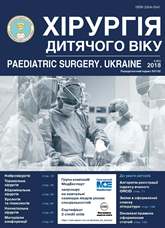Longitudinal enteroplasty as a method of primary treatment in newborns with proximal jejunal atresia
DOI:
https://doi.org/10.15574/PS.2018.61.87Keywords:
atresia, longitudinal resection, tapering enteroplasty, surgical treatment, newbornAbstract
The proximal segment in case of intestinal atresia is blind-ended, dilated and hypertrophied, has no effective peristalsis. This leads to the development of small intestinal bacterial overgrowth syndrome, malabsorption and poor adaptation of the small intestinal ends during enteroenterostomy. A typical approach to surgical correction of intestinal dilatation is resection of the dilated segment. Real challenges occur if a sufficient intestinal resection impossible due to the short proximal segment or if such a resection may lead to the development of short bowel syndrome. This article describes the clinical case of jejunal atresia in a newborn. The abnomality was diagnosed using prenatal ultrasound. The fetal follow-up examination included prenatal ultrasound monitoring. The baby is delivered by vaginal birth, at 38 weeks of gestation. Surgical treatment for diagnosed congenital abnormality was performed in 8 hours after birth. During the surgery, a jejunal atresia was found at the level of 7 cm from the Treitz’s ligament. The proximal segment of jejunum was dilated up to 3.5 cm and passed into a narrowed (up to 0.6 cm) distal one. After the enterotomy, a perforated membrane of the jejunum was found. A longitudinal tapering enteroplasty of the proximal intestinal segment to the level of Treitz’s ligament was conducted, after which an anastomosis was carried out. After the conducted surgery, the signs of organic and functional intestinal obstruction were not observed, and full enteral nutrition was achieved. The outcomes of conducted surgical treatment are good. Proposed tactics and strategy of proximal jejunal atresia surgical management is efficient and may be used if it is found impossible to perform a sufficient extent of small intestine resection or preserve its original length.References
Puri P, Golvart M. (2009). Atlas detskoy operativnoy hirurgii Puri. Moskva: MEDpress-inform: 648.
Baglaj SM, Czernik J, Koryszko J et al. (2001). Natural history of experimental intestinal atresia: Morphologic and ultrastructural study. J Pediatr Surg. 36: 1428–1434. https://doi.org/10.1053/jpsu.2001.26392; PMid:11528622
George W Holcomb III, J Patrick Murphy, Daniel J Ostlie. (2014). Ashcraft’s Pediatric Surgery. 6th Ed. Philadelphia: Еlsevier saunders: 1040.
Khen N, Jaubert F, Sauvat F et al. (2004). Fetal intestinal obstruction induces alteration of enteric nervous system development in human intestinal atresia. Pediatr Res. 56: 975–980. https://doi.org/10.1203/01.PDR.0000145294.11800.71; PMid:15496609
Laufman H, Martin WB, Method H. (1949). Observations in strangulation obstruction, the fate of sterile devascularized intestine in the peritoneal cavity. Arch Surg. 59: 550–64. https://doi.org/10.1001/archsurg.1949.01240040558019; PMid:18138067
Paul W Wales, Sanjeev Dutta. (2005). Serial transverse enteroplasty as primary therapy for neonates with proximal jejunal atresia. Journal of Pediatric Surgery. 40: 31–34. https://doi.org/10.1016/j.jpedsurg.2004.11.005; PMid:15793710
Downloads
Issue
Section
License
The policy of the Journal “PAEDIATRIC SURGERY. UKRAINE” is compatible with the vast majority of funders' of open access and self-archiving policies. The journal provides immediate open access route being convinced that everyone – not only scientists - can benefit from research results, and publishes articles exclusively under open access distribution, with a Creative Commons Attribution-Noncommercial 4.0 international license(СС BY-NC).
Authors transfer the copyright to the Journal “PAEDIATRIC SURGERY.UKRAINE” when the manuscript is accepted for publication. Authors declare that this manuscript has not been published nor is under simultaneous consideration for publication elsewhere. After publication, the articles become freely available on-line to the public.
Readers have the right to use, distribute, and reproduce articles in any medium, provided the articles and the journal are properly cited.
The use of published materials for commercial purposes is strongly prohibited.

